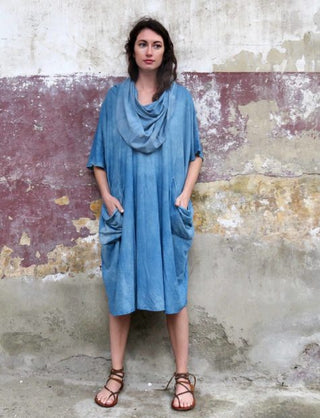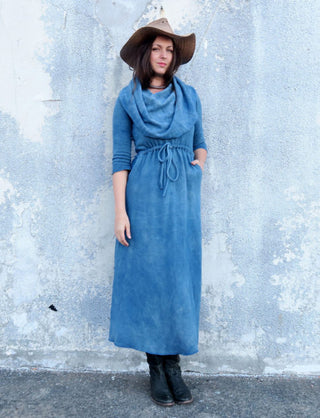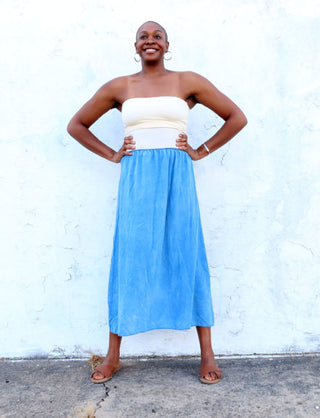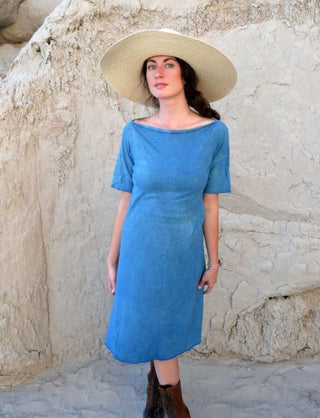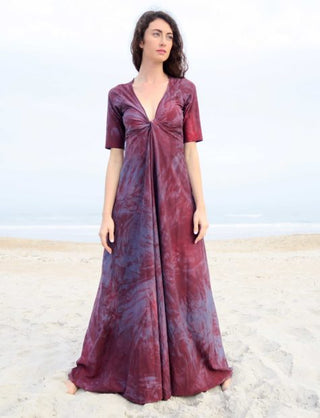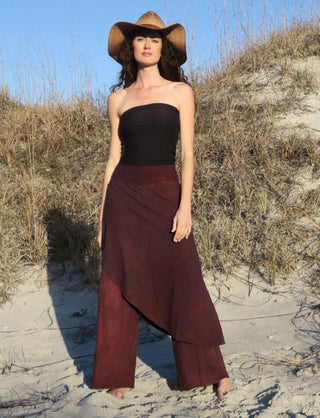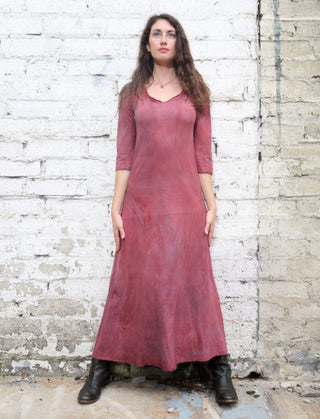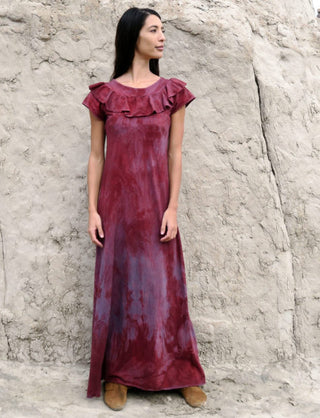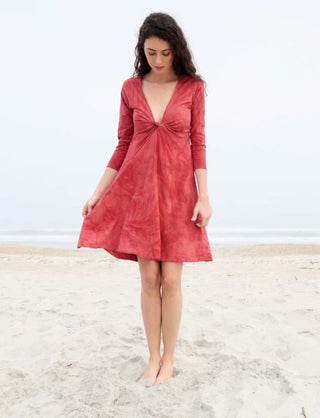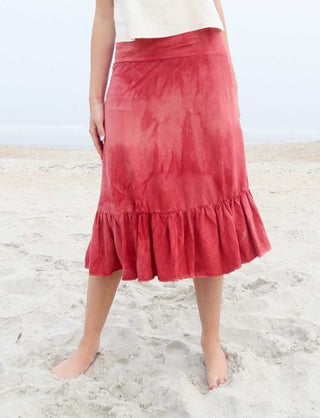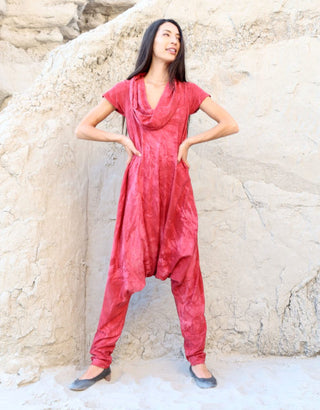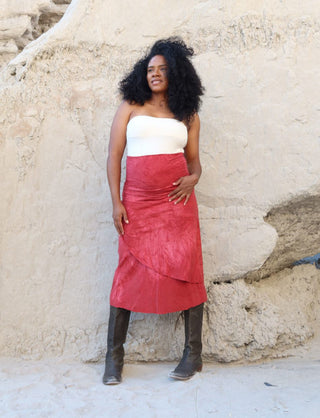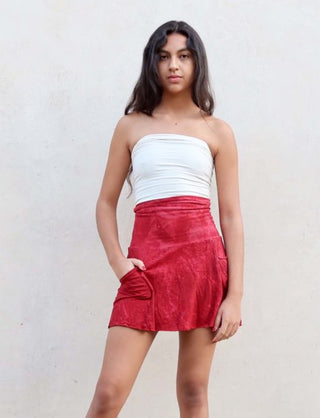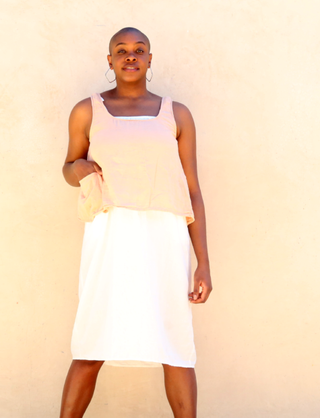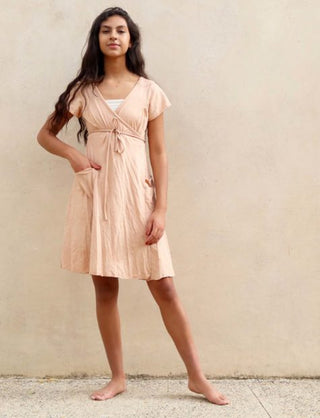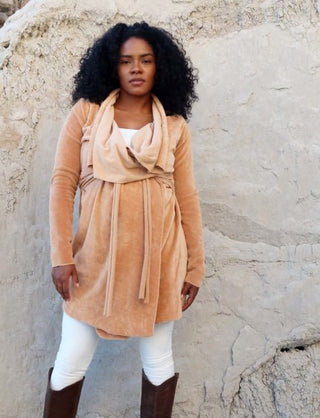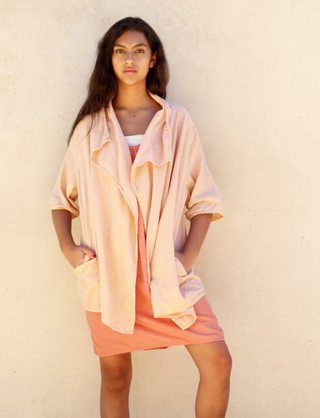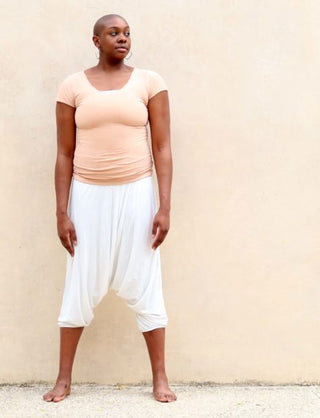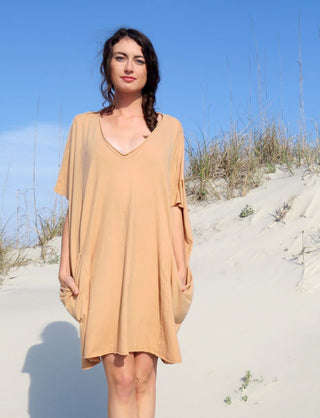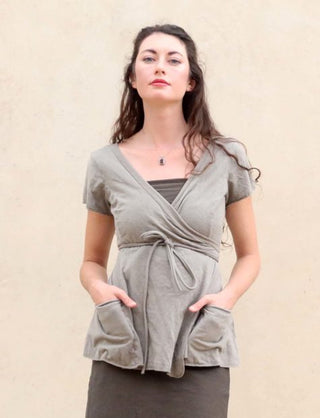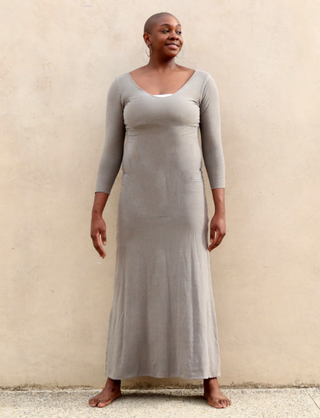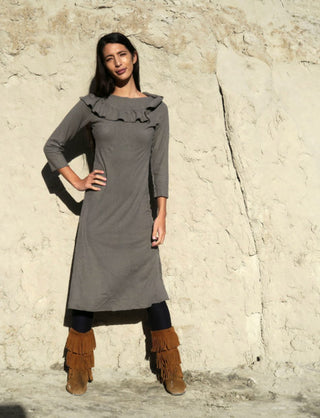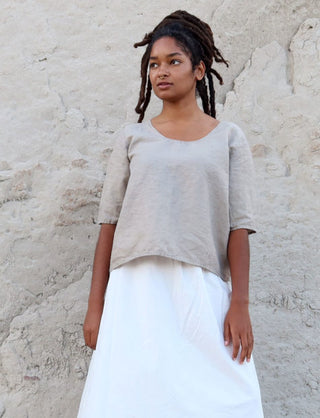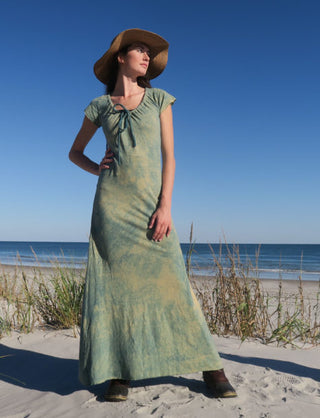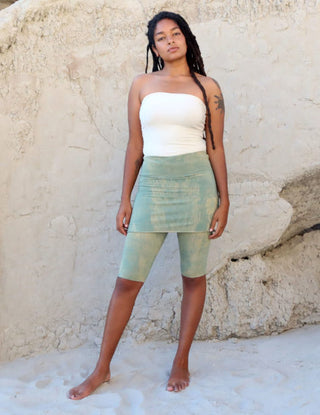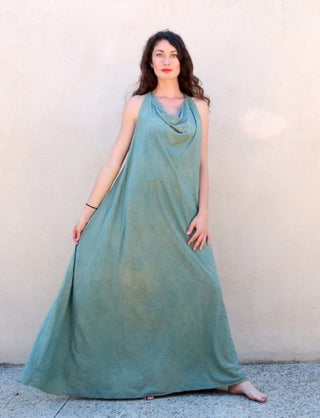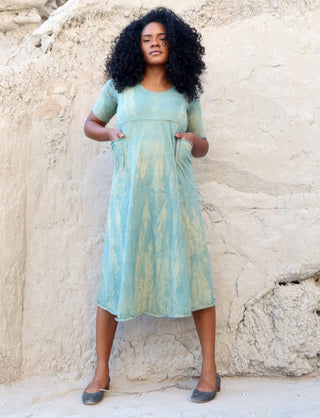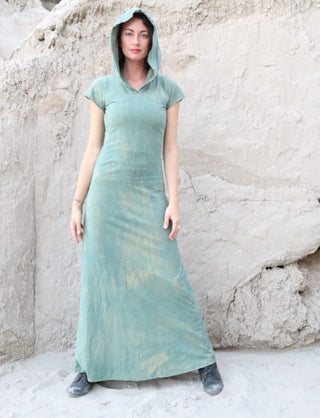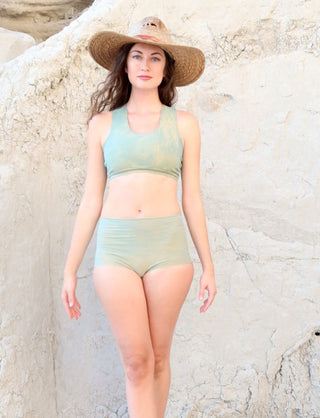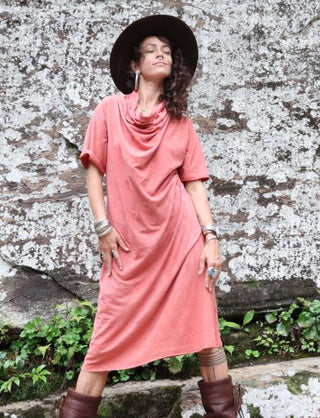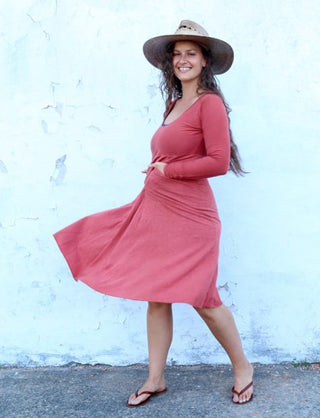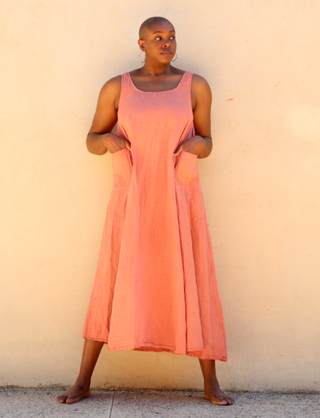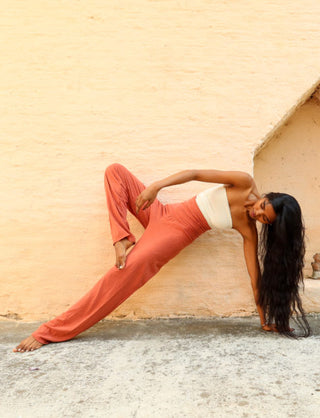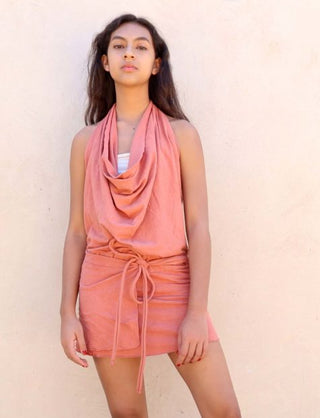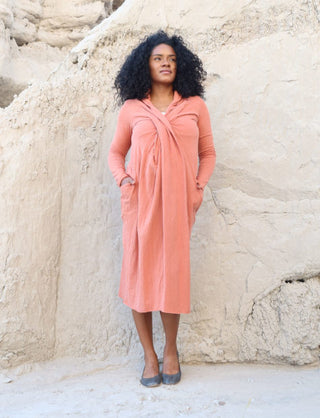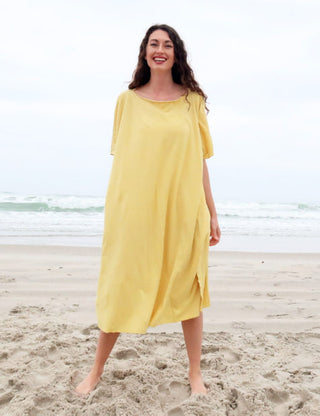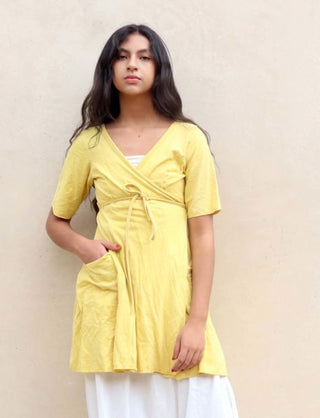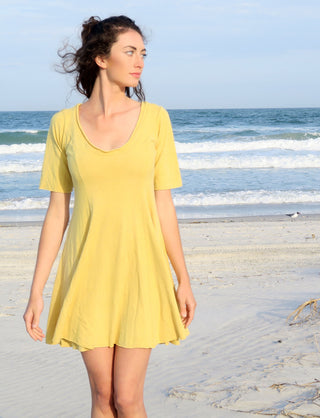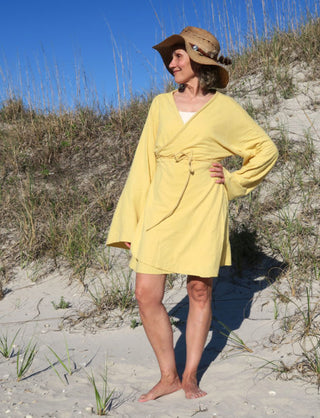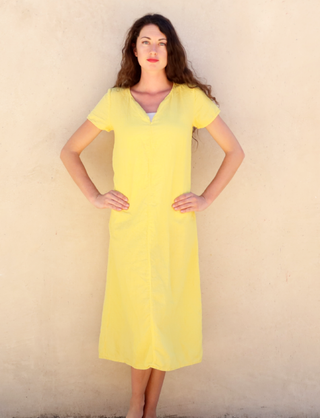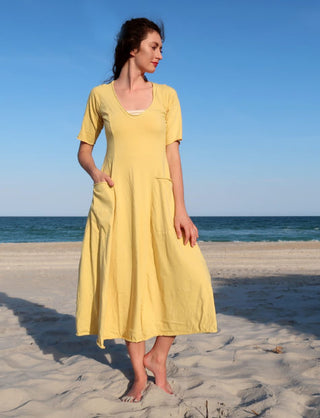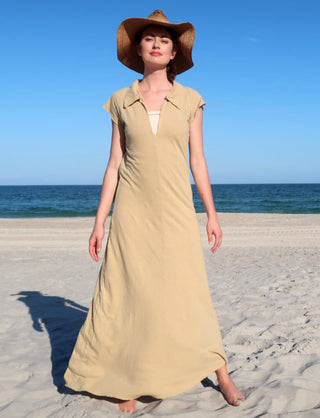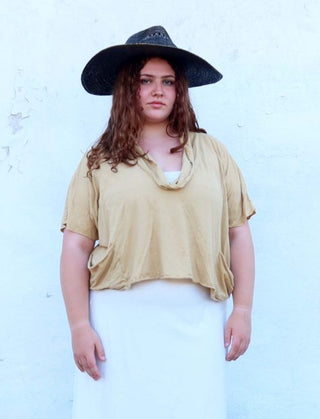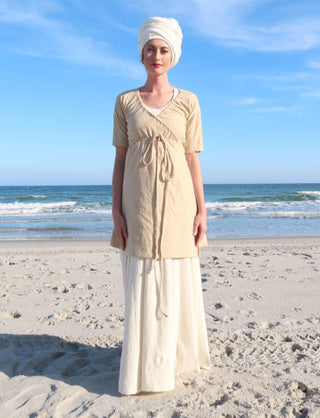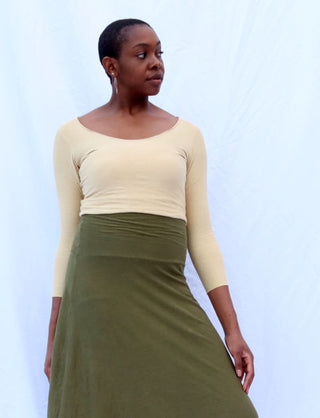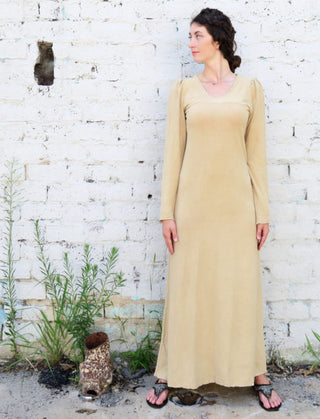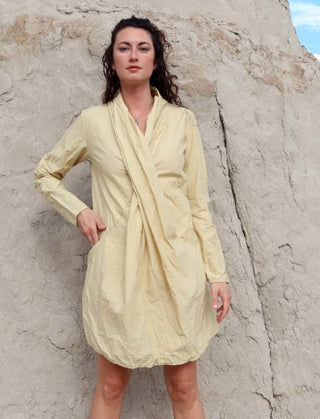Natural Dyes
We use a range of plant materials, insects, and pigments to create our natural dye clothing. If you enjoy an appearance that can range from a tie-dyed effect to darker and lighter spots then Natural Dyes are a great choice. Natural dyes do tend to fade faster then the fiber reactive dyes but they have amazing wellness benefits and are hands down the most eco friendly. Plant dyes can easily be bleached or stained by natural soaps, deodorants, and detergents and as such require more effort and mindfulness when worn and laundered. Acidic foods such as orange juice can remove natural dye colors if spilled on the naturally dyed fabric.
Natural dyes are as unpredictable as nature itself, so if you are looking for a deep saturation with little to no imperfections and easy wash and go we recommend choosing a Fiber Reactive Low Impact Dye color over our natural dyes.
The Beauty of Hand Dyed Garments
Inconsistency and variations of color is to be expected and part of the beauty of hand dying organic fabric. This means our colors will shift from dye bath to dye bath and from season to season, based on the specific conditions when each fiber was grown. It is truly our joy to honor the Nature of Nature by allowing her to speak through our clothing in this way. Thanks so much for joining us and we hope you enjoy your one of a kind Gaia Garment.
Variations in Color
Below are clothing images of our Natural Plant Dye Color options on a range of fabrics. We cannot create one color variation over another, or control how color may appear on your computer or mobile device’s screen so please expect a slight variation of the colors shown below. Colors will always look different depending on your computer’s color settings, the settings of the camera and light when an image was taken, and your individual color perception.

INDIGO
A range from light to med blue, similar in appearance to denim.
INGREDIENTS:
Alum and Tannin Mordant, Indigo Vat Dyeing Method which includes Indigo, Madder, Soda Ash, and Yeast
MEDICINE AND MAGIC:
Indigo, derived from the plant Indigofera tinctoria, has long been revered not only for its deep, vibrant color but also for its medicinal and magical properties. Historically, indigo dye was believed to have therapeutic qualities, particularly in traditional medicine where it was used as a poultice or applied topically to treat skin ailments like rashes, boils, and wounds due to its mild antiseptic properties. In magical traditions, indigo is associated with the third eye chakra, promoting intuition, wisdom, and spiritual awareness. Its deep blue hue is thought to invoke a sense of calm, helping with mental clarity and emotional balance. Additionally, indigo has been used in rituals to ward off negative energies and as a symbol of protection. In both healing and spiritual practices, the rich, indigo color is often seen as a bridge between the physical and metaphysical worlds.
CHAKRA:
Third-eye – Ajna

amethyst
A marbled purple, blue, and pink created by layering 3 colors. The surface has a tie-dyed appearance created with layers of natural plant dye colors
INGREDIENTS:
Alum and Tannin Mordant, Madder, Cochineal, Indigo, soda ash, yeast
MEDICINE AND MAGIC:
Madder, from the root ofRubia tinctorum, has long been used to treat ailments like poor circulation and kidney issues due to its anti-inflammatory and diuretic effects. It is also linked with protection, healing, and love in magical traditions. Indigo, derived from Indigofera tinctoria, is known for its calming, grounding effects and is associated with wisdom, intuition, and spiritual awakening. Cochineal, made from crushed cochineal insects, was revered for its purifying and protective qualities, used historically to treat fever and digestive issues, and symbolizes vitality and passion in magical rituals. Together, these dyes aid in accessing ones intuition while staying grounded.
CHAKRA:
Crown – Sahasrara

poppy
A marbled red. The surface has a tie-dyed appearance created with layers of natural plant dye colors.
INGREDIENTS:
Alum and Tannin Mordant, Madder, Cochineal, chalk
MEDICINE AND MAGIC:
Madder, from the Rubia tinctorum plant, produces deep red to orange hues and has been used to treat ailments like UTIs, skin conditions, and inflammation. It was also believed to offer protection, used in ritual garments or as amulets. Cochineal, a red dye from the cochineal insect, has been prized since ancient times, especially in Mesoamerica. It was used to treat fever and digestive issues, and symbolized vitality and strength. Both dyes, linked to power, love, and courage, have long connected healing, spiritual practices, and art.
CHAKRA:
Root – Maladhara

sandalwood
A light earthy brown with hints of orange
INGREDIENTS:
Alum and Tannin Mordant, Sandalwood
MEDICINE AND MAGIC:
Sandalwood, when used as a dye, offers a fascinating blend of medicinal and magical properties that have made it highly revered across cultures for centuries. Medicinally, sandalwood is known for its soothing and anti-inflammatory properties, often utilized in traditional remedies for skin irritations, stress relief, and even as an antiseptic. When applied as a dye, sandalwood imparts a rich, warm, golden hue, and is believed to carry an aura of tranquility and spiritual healing. In the magical realm, sandalwood is associated with purification, protection, and enhancing meditation practices. It is said to calm the mind, deepen concentration, and open the path to higher consciousness. The act of using sandalwood as a dye, especially in ritualistic or sacred garments, is thought to infuse the wearer with a sense of peace, clarity, and connection to the divine. Whether for its practical or mystical benefits, sandalwood’s dye continues to be a symbol of harmony and healing.
CHAKRA:
Sacral and Soul Star

pewter
A drab grey with green undertones
INGREDIENT
Alum and Tannin Mordant, Pomegranate, Iron Rinse
MEDICINE AND MAGIC:
Pomegranate and iron have long been revered for both their medicinal and magical qualities, especially when used in the art of dyeing. Pomegranate, rich in antioxidants and historically prized for its healing properties, is known to symbolize fertility, abundance, and renewal in various cultures. As a dye, its rind produces a vibrant, earthy yellow to golden hue, often thought to possess protective and purifying powers. Iron, when used as a mordant, not only strengthens the color but also lends a dark, mystical depth to the fabric, creating deep, almost enchanted tones of brown, gray, or black. Combined, pomegranate and iron are believed to work together in a synergistic way, weaving together the energies of health and protection, and often used in traditional rituals to safeguard the wearer and promote emotional strength. The resulting fabric is not only a work of art but also a talismanic object, carrying both the physical and metaphysical essence of its ingredients.
CHAKRA:Solar Plexus and Heart

sage
A marbled green created from layering Indigo over tan. The surface has a tie-dyed appearance created with layers of natural plant dye colors.
INGREDIENTS:
Alum and Tannin Mordant, Pomegranate, Indigo, madder, soda ash, yeast
MEDICINE AND MAGIC:
Pomegranate and indigo have long been prized not only for their rich hues but also for their unique medicinal and magical properties. Pomegranate, with its vibrant red juice, has been used in traditional medicine for its antioxidant, anti-inflammatory, and antibacterial benefits, promoting overall health, especially in ancient cultures. As a dye, it creates a warm, earthy tone, often associated with vitality and protection in magical practices. When paired with indigo, which is renowned for its deep, calming blue shade, a powerful contrast is formed. Indigo has been revered as a symbol of wisdom and intuition and was historically believed to offer spiritual protection and promote mental clarity. In magical traditions, the combination of these two dyes represents a balance between the physical and spiritual realms, enhancing one's connection to both the earth and the cosmos. Together, pomegranate and indigo create textiles that not only carry aesthetic beauty but also infuse wearers with a sense of healing, protection, and insight.
CHAKRA:
Third Eye and Heart
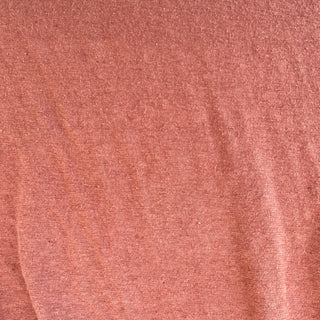
Fox
This is an earthy terra-cotta orange with a marbled or tie-dyed appearance created with layers of natural plant dye colors.
INGREDIENTS:
Alum and Tannin Mordant, Madder, Cutch
MEDICINE AND MAGIC:
Madder and cutch, both traditional dyeing materials, have been prized not only for their rich colors but also for their medicinal and magical properties. Madder, derived from the root of Rubia tinctorum, produces a deep red dye that has been used in herbal medicine for centuries. Its properties are thought to aid in blood circulation and help treat conditions like kidney stones and inflammation. Magic-wise, madder was historically associated with love and protection, often used in spells to enhance passion and guard against negative energies. Cutch, obtained from the heartwood of Acacia catechu, yields a rich brown dye and has been valued for its astringent and antiseptic qualities. In folk medicine, cutch was used to treat diarrhea, sore throats, and wounds. Magically, cutch was believed to offer grounding and purification, often used in rituals for cleansing and to invoke stability. Both dyes, when used together in textiles, carry an additional layer of symbolic protection and healing, making them not just sources of vibrant color, but powerful tools in ancient practices.
CHAKRA:
Sacral and Soul Star

SUNSHINE
A very mellow earthy yellow
INGREDIENTS:
Alum Mordant, Fusticwood
MEDICINE AND MAGIC:
Fustic wood, derived from the Cholorophora tinctoria tree, has been valued for centuries both for its medicinal and magical properties, especially in its role as a dye. When used as a dye, fustic wood yields a rich, golden-yellow color, making it prized in textile arts. In traditional herbal medicine, fustic has been considered a potent treatment for various ailments, particularly for its ability to support digestive health and reduce inflammation. It was also thought to have antiseptic qualities, helping to cleanse the body. Magically, fustic wood is often associated with protective spells, especially those aimed at purification and warding off negative energy. Its warm, vibrant hue is believed to symbolize vitality and prosperity, and it is sometimes used in ritual work to bring light and positivity into one’s life. Whether as a dye, a healing agent, or an ingredient in magical practices, fustic wood bridges the natural and mystical worlds, offering both practical and spiritual benefits.
CHAKRA:
Solar Plexus and Soul Star

POMEGRANATE
An earthy tan with green undertones
INGREDIENT:
Alum and Tannin Mordant, Pomegranate
MEDICINE AND MAGIC:
When used as a dye, pomegranate has both medicinal and magical properties that enhance its natural potency. The fruit's rind, particularly, yields a rich, golden-yellow to deep reddish-brown hue, which has been prized for centuries in textile and ceremonial use. Medically, the dye from pomegranate is believed to possess antibacterial and anti-inflammatory properties, making it beneficial in traditional wound care and skin treatments when applied topically. In magical contexts, pomegranate dye is often used in rituals involving protection, healing, and vitality. The color itself—symbolizing the vibrant life force of the fruit—can be used in spells to promote renewal, fertility, or prosperity. It is also said to imbue garments or objects with energies of transformation and abundance, making it a popular choice for creating talismans, ritual cloths, and magical garments. In this way, pomegranate dye merges the natural world with the mystical, combining both medicinal and magical benefits.
CHAKRA:
Solar Plexus and Heart


